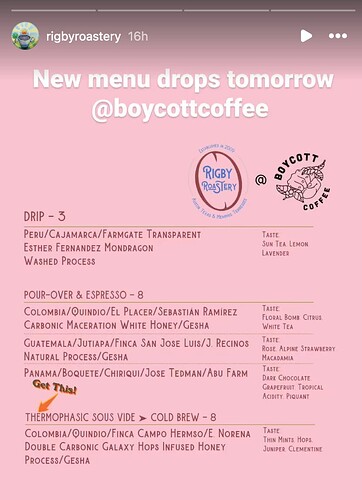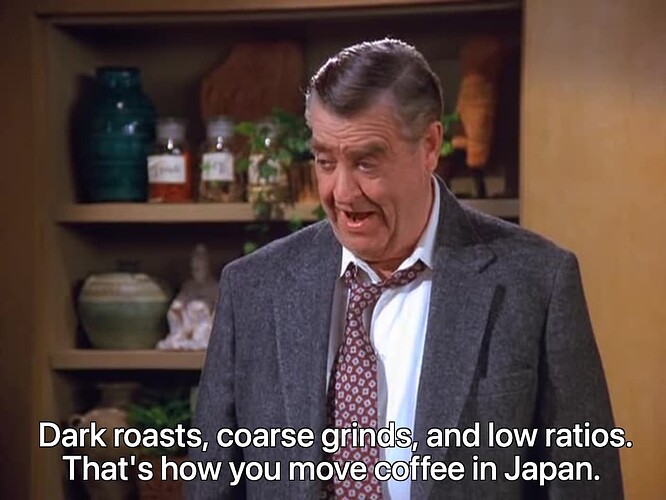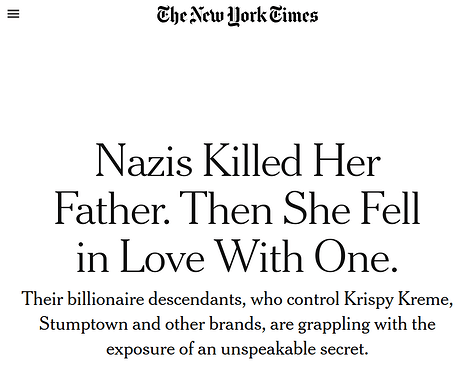ok yeah that’s what I figured. the new ones are … ok. but they’re clearly shittier than the old ones. The old ones I would get very consistent drain times with the same beans at the same grind (within 5 seconds), with the new ones I can get variance as much as 20 seconds from one brew to the next.
this lead to me having to “explain” da share z0ne to my wife yesterday
“why is this funny”
“what is he sorry about”
of course “why is this funny” is never going to lead to a productive conversation, and my wife of course knows that there is a ton of extremely dumb shit I laugh at that she will never find even moderately humorous. But I do think she at least got the idea when I showed her this one:
more instant cafe reviews, Denver edition:
River North area:
-
Lekker Coffee - opens early (big plus in my book) decent but unremarkable shot, I really needed some sparkling water (this was my first stop and I was a little dried out from the mountain air) but I had to buy a topo chico. Big space, friendly baristas, B-.
-
Corvus Coffee (several locations) - excellent space with bar seating in a new residential “five over one”, very, very good shot, served by the book (spoon, sparkling water, on a little tray, just the way I like it), very nice and knowledgable baristas. This was a bit out of my way but I’m glad I made the trip. A.
-
Blue Sparrow: small space, good vibes, shot was acceptable, served with sparkling water, barista seemed competent, B.
Ballpark area:
-
Milk and Honey: great cafe space (lots of plants, I’m way more into the “jungle cafe” aesthetic than the “apple store cafe” aesthetic, decent shot (water/spoon etc), friendly and competent baristas, B+
-
Huckleberry Roasters: in a hotel lobby, really poor seating options, not a great vibe, coffee was mid, C-
Union Station area/Downtown:
-
Amante: small space, not really very welcoming, shot was very good, but was served in this weird thing that was bigger than a demitasse yet still smaller than a tea cup, came with a tiny little biscotti, knowledgable baristas, B.
-
Little Owl: Very nordic/apple store vibe, limited seating, shot was A++++ and served with all the fixin’s, barista seemed very competent (not very talkative), A+
anyone know how well these things work, are they worth it?
Generally I go through a 250g bag in about 4 -5 days, and I haven’t noticed a huge drop-off in quality from the beginning to the end (hard to tell since it sometimes takes 2 days to even get dialed in). Feels like the regular bag they come in seals well enough if you push all the air out, but… maybe not? Also since I am back to traveling occasionally, sometimes a bag will just sit there for a few extra days after opening.
I tried the “carbonic maceration” gesha on espresso and it was pretty weird, not really my idea of a great cup but a pretty worthwhile experience, and I got a little sample of the cold brew, it was pretty wild, very interesting stuff
I like the Airscape. It’s well made and does what it’s designed to do. Like you mentioned, most specialty bags work just fine if you squeeze the air out, so my Airscape is mostly for the roasters who don’t use bags with seals. I also have some generic unbranded bags and an assortment of older empty bags that work well for that too though.
I still don’t understand the bag break effect and have never seen anyone explain it adequately. Break right off roast and get 2-3 days of Yahtzee balls followed by an immediate sharp decrease in quality that lasts for 1-2 weeks before it comes back to life. Hashtag not all coffees but a lot of them for sure. Somebody make it make sense.
not yet, I think I can hold off for a few months but I suspect I’ll break down this summer
I hate to bump a 13-month-old post but somehow this just popped into my head, sorry my brain has been broken lately
What is the coffee pro opinion on Stumptown? Actually good product or just swill that appeals to normies who don’t know any better?
I have never bought their beans but I’ve had decent espresso in their cafes
Did they serve it right with the water and spoon and whatnot?
They were an early player in third wave acquiring brand equity when there was less competition, knowledge, and demand. Now they are under the Peet’s umbrella (along with Intelligentsia) which is controlled by private equity. In fact, it’s been under private equity control since 2011 with the current group acquiring in 2015. Since then I’ve noticed it appearing in many supermarkets, so place your bets on whether they’re trying to provide excellent coffee for a fair price. See also:
Wow, that was way more than I was looking for, but still very interesting.
Have you ever tasted the stuff?
Yes, I’ve had several bags of it and none were remarkable, although I could say that for a lot of big name roasters. If they have any limited release single origins you might hit on one but I can’t think of a reason why I’d buy their coffee today with so many micro-roasters operating.
Here’s a bit more detail that may somewhat demystify all of this:
Remember that specialty grade is usually any coffee scoring >= 80 out of 100 on the SCA cupping sheet with no category one defects. It’s an inexact specification because it depends on the graders, but nonetheless not a particularly high bar and the grade vs. cup quality relationship in this range is highly nonlinear. True 90+ coffees are rare but remarkable, whereas coffees in the 80-85 range may leave you wondering what all the fuss is about if that’s your entry point into “good” coffee. In my decade+ of doing this, I’d guess I’ve only had a couple dozen truly remarkable coffees at most.
The upper quartile green price for the low end of this range is about $2/lb. For 86-88 it jumps to around $4/lb, and 88+ is about $8/lb. And again this distribution is highly skewed, so the 88+ category is dominated by coffees scoring below 90. True 90+ coffees likely double again to $16/lb but that quickly gets to the range where pricing goes from geometric to asymptotic and the sky is the limit.
Keep in mind I’m talking about cupping scores, which are already noisy and tend to be inflated, and that the translation to filter (or espresso) isn’t necessarily exact. There are several reasons for this, one being the quality of the roast, but I’m strongly of the opinion that roasters do not add anything to coffee quality in the roasting process. In other words, roasters aren’t buying 84-point coffees and skillfully roasting them into 88-point coffees. That’s not how it works and is critical to understanding how you’re going to consistently lay hands on exceptional coffees at reasonable prices.
You can probably see what the problem is here: When it became obvious that people will pay really high prices for “specialty” coffee, the market attracted the big brain capitalists who want to sell you $2/lb coffee for $30/lb. There’s no requirement that anyone posts a cupping score or even the price paid for the green, which is why you’ll rarely find either. And if they do post cupping scores, they’re likely to be inflated and/or marketing tactics to charge even higher prices. That’s why I bargain hunt CoE winners and microlots while remaining mostly roaster agnostic.
Another source on this, of which there are many.
Kelly suggests the SCAA’s 20-point scoring zone is too generous. “An 84-points coffee (let alone a sub-80 one) tastes like stuff I don’t want to put in my mouth, and life is too short,” he says.
Some interesting points in here about how the quality signals are constantly changing because all of the terms get co-opted by hucksters. I used to watch a lot of “indie” films which were completely bought out by major studios as soon as they had viable commercial success, and then you’d see the IFC and Sundance logos on the posters for these things churned out by fake subsidiaries of Universal, Paramount, and whatever. I’m sure COE and microlot will be next on the list.
Much longer and incredibly detailed read on the declining quality of Kenyan coffee. This one has a nerd factor of 10. I started noticing this maybe 6-7 years ago when my local roaster who used to source great AA suddenly could only get AB that was mediocre at best. They aren’t a big name and don’t sell online so were probably some of the first to get squeezed out, but I also noticed that the reputable national roasters I buy from most often rarely have Kenyans anymore. My observation is that Ethiopian coffees have experienced a similar decline and I find myself buying fewer and fewer of them these days as well.



